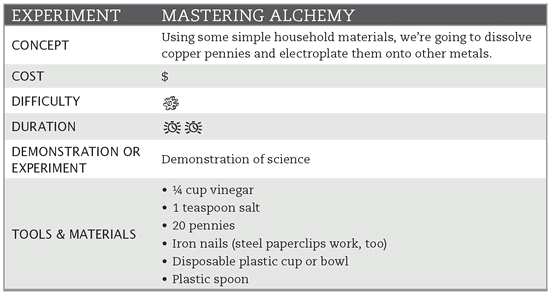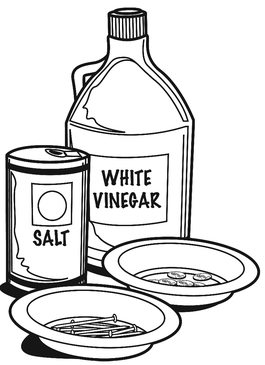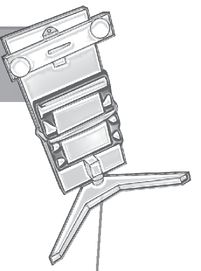Mastering Alchemy
Idea by Kathy Ceceri
Here’s the scenario: double apocalypse! A giant rogue asteroid is hurtling toward Earth, and for the first time in recorded history all of the countries in the world have joined together to launch a huge barrage of nuclear weapons out into space to deflect/ destroy it.
Except it doesn’t work. Damned metric conversions!
And so, now the 721 major pieces of the broken-apart-but-not-destroyed-and-now-radioactive-asteroid have come through the atmosphere and wiped out 95 percent of humanity. Plus they have melted all the ice on both poles, raising sea levels so high that every major population center, save a few, is under water (La Paz is doing okay).
It’s an interesting time to be a mad scientist.
Of course, things are back to a barter economy. Certain metals are quite scarce (everything’s under water), and what’s left fetches a high price as people need metal to repair the electronics that have survived. Like copper. It was a lucky thing you’d squirreled away your penny collection in your secret laboratory and fortress hidden in a mountain for just such an occasion.
You’ve got a lot of pennies, but not enough to fund your rise to power as the Emperor of New North America, so you’re going to have to stretch your funds a little. Luckily you know science, and have access to three very important things: salt, vinegar, and a nearly unlimited supply of paper clips (pilfering your local Office Depot just after the asteroid impact was a stroke of genius).
With these supplies, you’re going to be able to figuratively print yourself money! Well, really, you’re going to electroplate paperclips so people think they’re made of copper. But no one will figure that out until it’s too late!
Muahahahahaha!
Back in the days before we even understood atoms and molecular structure, people called alchemists searched for a way to turn one element (lead, for example) into another (gold, for example) because it would be a huge increase in the metal’s value. But while it was born out of magic and superstition, alchemy became the basis of the science of chemistry. Many of the tools and techniques first developed by alchemists in the Middle Ages are still used in chemistry labs today.
You can’t turn one element into another, at least not without a nuclear reaction and/or a particle accelerator (let’s welcome the newly created elements 114 and 116 to the periodic table, everyone!—they were created in laboratories by smashing smaller elements into bigger ones), but through the “magic” of chemistry you can make iron (Fe) look like copper (Cu). The trick is to coat the iron with a thin layer of copper, a process called copper plating.
STEP 1: To start, we’re going to mix up a strong acid solution. Okay, not that strong. It won’t be alien-blood-eat-through-the-floor acid. Just something we can dissolve some pennies with!
Pour ¼ cup vinegar into the plastic bowl. Stir in 1 teaspoon of salt. The vinegar is a solution of acetic acid (CH3COOH) and water (H2O), useful as a weak solvent or an ingredient. Salt (NaCl) is made up of sodium and chlorine. When you mix them, they combine to form a slightly stronger solvent called hydrochloric acid (HCl).
STEP 2: Use the acid to dissolve copper from the pennies! Put 20 dull pennies in the bowl with the acid. Let them soak for about 5 minutes, then remove them and let dry on a paper towel.
STEP 3: Now we’re going to turn some iron nails or steel paperclips into “apparently” copper nails or paperclips, using the acid solution.
Once the pennies have been removed from the bowl of acid, add the nails or paperclips (leave one out for comparison so you can see the difference when you’re done). You can also stand or prop one item up so it is half in and half out of the solution.
Look closely and you will see bubbles forming on the surface of your items. This is a sign that a chemical reaction is taking place. The bubbles are hydrogen gas being released by the chemical change.
Here’s the hard part: You’ll have to leave them for a while, like a couple of hours or more. But after that time, the nails or paperclips should turn a bright coppery orange. You did it! You’re an alchemist!
Well, not really. You’re a copper-plater instead. What really happened is that, just like the copper from the pennies, some of the oxidized metal on the surface of the nails or paperclips dissolved in the acid solution, releasing positively charged iron ions (Fe+2 ). Meanwhile, the extra electrons left behind gave the surface of the nails a negative charge. Because copper is more “noble” than iron (a chemical term meaning that copper goes into a dissolved state less easily than iron), the copper ions were more strongly attracted to the iron nail than the iron ions.
What Else Can I Do?
For an additional chemical reaction, repeat steps 1 and 2, but try rinsing some of the pennies in water before drying. The rinsed pennies will remain shiny clean. Un-rinsed pennies will start to turn green as they dry. This greenish coloring, like the copper of the Statue of Liberty, is called verdigris. It is a layer of copper carbonate (CuCO3) formed by a reaction with the acid.
But what happened to the dull coating on the dull pennies? Did we go through that just to wash them? Nope! That dull coating was a layer of copper oxide (CuO), formed when the copper on the surface of the penny reacted with the oxygen from the air (it’s the copper version of rusting). The HCl dissolved the CuO layer to release copper ions (Cu+2).
Ions are atoms that contain more or less than the normal number of electrons. The copper ions in the vinegar solution are positively charged because they left two of their (negatively charged) electrons behind when they separated from the rest of the copper penny.
Here is the chemical equation that shows this reaction: 3(CH3COOH) + H2O + NaCl + CuO = 3(CH3COO-) + 3H+ + 2OH- + Na+ + Cl- + Cu+2
True copper plating is done with much more powerful chemicals, and produces a much smoother, sturdier coating. What you’ve created can probably be scratched off, so it won’t hold up under serious scrutiny. But it should be enough to make a trade with some unwitting survivors of the apocalypse for other valuable materials and equipment!
Beyond that, knowing how to copper plate is cool. If the future is steampunk and retro futuristic as we hope, being able to add a shiny copper coating to all your iron and steel snaps and zippers will make you the best decked-out mad scientist around.



